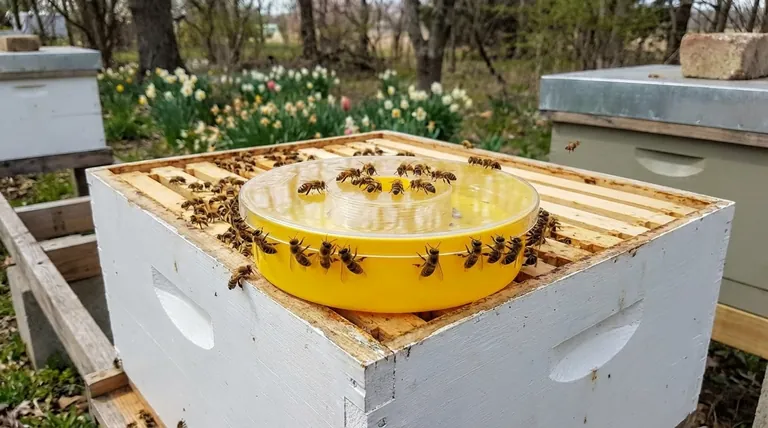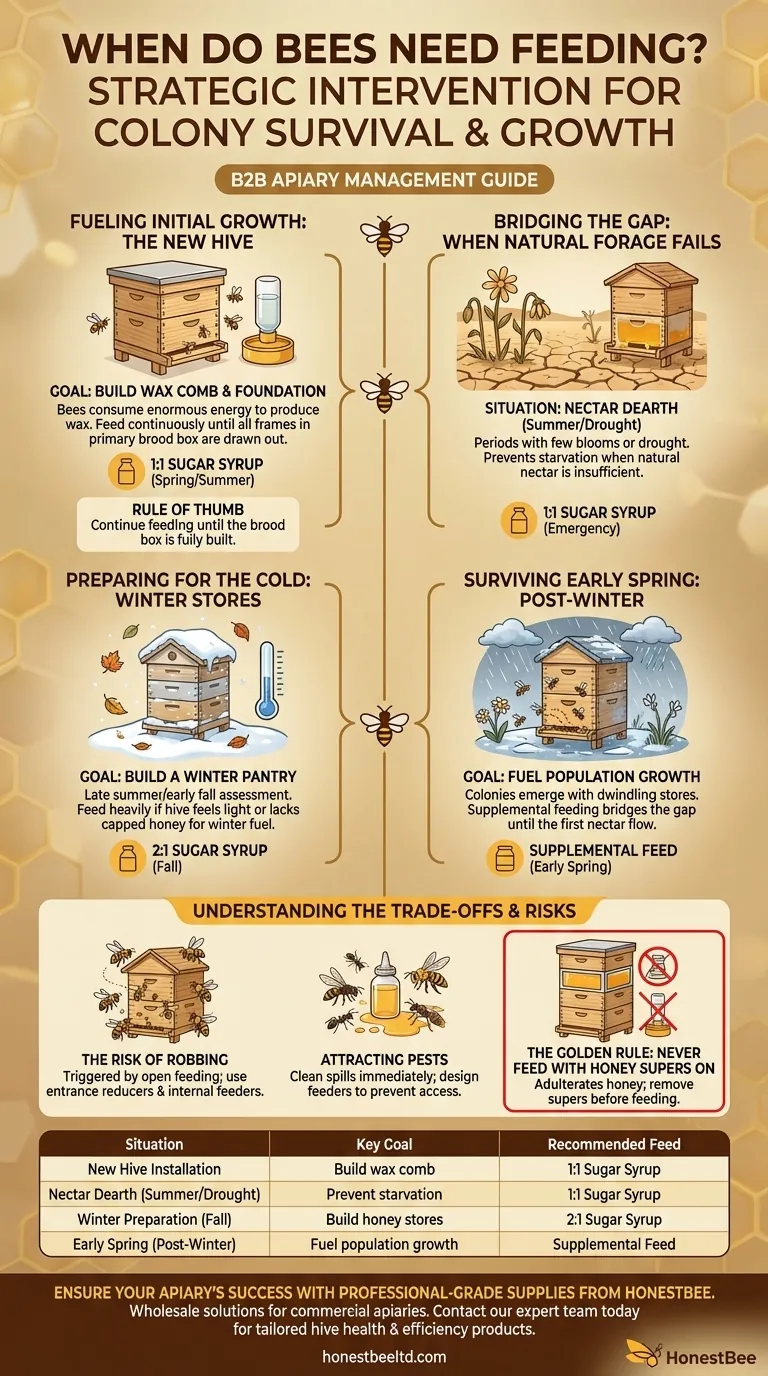Bees require feeding in a handful of critical situations when their natural food supply, nectar, is insufficient. This supplemental feeding is a management tool used to ensure a colony's survival and growth, particularly when establishing a new hive, during periods of poor nectar flow, or when preparing for and emerging from winter.
Feeding bees is a strategic intervention, not a routine task. It's about providing targeted support when natural resources are insufficient for the colony's immediate needs for survival, growth, or winter preparation.

Why Colonies Need Supplemental Feeding
A beehive is a complex system that runs on the energy from nectar (carbohydrates) and the protein from pollen. When nectar is unavailable, the colony's most critical functions—from building comb to raising young—can grind to a halt.
Fueling Initial Growth: The New Hive
When you install a new package of bees or a nucleus hive, they are starting with little to no infrastructure.
Building the Foundation: Wax Production A new colony's first job is to build wax comb. Bees consume enormous amounts of sugar to produce tiny flakes of wax from glands on their abdomens. Feeding provides the cheap, abundant energy needed for this intensive construction project.
The Rule of Thumb You should continue to feed a new hive until all the frames in their primary brood box are "drawn out," meaning they are fully built up with wax comb.
Bridging the Gap: When Natural Forage Fails
Even established hives can face periods of starvation.
Understanding the Nectar Dearth A "nectar dearth" or "nectar gap" is a period when few nectar-producing flowers are in bloom. This can happen in the heat of mid-summer or during a drought. Without incoming food, the hive must rely on its stored honey.
Emergency Intervention If a hive has consumed its honey stores during a dearth, feeding becomes necessary to prevent starvation. This ensures the queen continues to lay eggs and the colony can maintain its population.
Preparing for the Cold: Winter Stores
A colony's ability to survive winter is directly tied to the amount of honey it has stored.
Building a Winter Pantry In late summer or early fall, you must assess the hive's weight. If it feels light or you see insufficient capped honey, you need to feed heavily. This allows the bees to process the sugar syrup and store it as "honey" for their winter fuel.
Surviving Early Spring Colonies emerge from winter with dwindling food stores just as the queen begins to ramp up egg-laying. A cold, wet spring can delay the first nectar flow, creating a critical starvation risk. Feeding in early spring can be the bridge that gets the colony to the first blooms.
Understanding the Trade-offs of Feeding
Feeding is a powerful tool, but it is not without risks. It is an unnatural intervention that must be managed carefully.
The Risk of Robbing
Feeding can trigger "robbing," where bees from stronger neighboring hives smell the sugar syrup and attack the weaker hive to steal it. This can quickly decimate a colony. Using entrance reducers and internal feeders can help minimize this risk.
Attracting Pests
Sugar syrup is a magnet for pests like ants, wasps, and yellow jackets. Spills should be cleaned up immediately, and feeders should be designed to prevent access by these other insects.
The Golden Rule: Never Feed With Honey Supers On
This is the most critical rule. If you feed a hive while honey supers (the boxes intended for human consumption) are on, the bees will store that sugar syrup in the honey comb. This adulterates the honey, and it can no longer be legally or ethically sold or labeled as pure honey. Always remove honey supers before you begin feeding.
Making the Right Choice for Your Goal
Your decision to feed should always be based on a specific, observable need within the hive.
- If you just installed a new hive: Feed a 1:1 sugar-to-water syrup consistently until the bees have built out all the comb in their brood box.
- If you are in a mid-summer dearth: Check your hive's food stores and feed a 1:1 syrup only if they are running low on honey to prevent starvation.
- If you are preparing for winter: In the fall, feed a thick 2:1 sugar-to-water syrup to help the bees quickly build up their winter honey stores.
- If your bees are emerging from winter: Provide supplemental food if natural forage is delayed to fuel the spring population boom.
Ultimately, thoughtful feeding empowers you to guide your bees through the most vulnerable points of their yearly cycle.
Summary Table:
| Situation | Key Goal | Recommended Feed |
|---|---|---|
| New Hive Installation | Build wax comb | 1:1 Sugar Syrup |
| Nectar Dearth (Summer/Drought) | Prevent starvation | 1:1 Sugar Syrup |
| Winter Preparation (Fall) | Build honey stores | 2:1 Sugar Syrup |
| Early Spring (Post-Winter) | Fuel population growth | Supplemental Feed |
Ensure your apiary's success with professional-grade supplies from HONESTBEE. As a wholesale supplier to commercial apiaries and distributors, we provide the reliable equipment and feeding solutions you need to manage critical situations effectively. Let's discuss how our products can support your hive health and operational efficiency. Contact our expert team today for tailored wholesale solutions.
Visual Guide

Related Products
- HONESTBEE Round Hive Top Bee Feeder for Syrup
- Professional Hive Top Bee Feeder for Beekeeping
- Rapid Bee Feeder White Plastic 2L Round Top Feeder for 8 or 10-Frame Bee Hives
- Professional Hive Front Entrance Bee Feeder
- HONESTBEE Entrance Bee Feeder Professional Hive Nutrition Solution for Beekeeping
People Also Ask
- What features make top feeders a reliable choice for beekeepers? A Guide to Safe, Efficient Hive Nutrition
- What is the correct method for preparing sugar syrup for bees? Ensure Safe, Non-Toxic Feeding for Your Hives
- How do hive top feeders work? A Guide to Efficient, High-Capacity Bee Feeding
- What safety features are included in top feeders? A Guide to Drowning Prevention and Hive Safety
- How do you set up and use a top feeder for bees? A Step-by-Step Guide for Safe Feeding



















